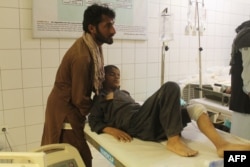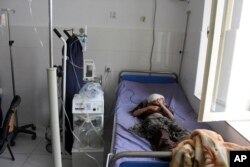An Afghan Air Force attack on an open-air religious gathering killed 30 children and wounded 51 more last month, according to a United Nations investigation published Monday.
At least six adults also were killed and 20 wounded when Afghan helicopters attacked the site in Kunduz province, where a group of men and boys had gathered to celebrate students' memorization of the Quran.
The Afghan government says it was targeting senior Taliban leaders, including members of the Quetta Shura, the group's Pakistan-based leadership council.
Kabul has acknowledged civilian casualties occurred, but initially suggested almost all of those killed were Taliban. It has promised to further investigate the incident.
The U.N. was not able to determine whether senior Taliban leaders were at the gathering. Witnesses told U.N. investigators that Taliban members attended, with some working as security guards.
Civilian casualties in Afghanistan remained near record-high levels in the first quarter of 2018, according to U.N. figures. Between January and March, 2,258 civilians were killed or injured.
The vast majority of civilian casualties were caused by insurgent attacks. But the Afghan Air Force has also come under greater scrutiny as it gains greater ability to carry out airstrikes.
Strategy questioned
Witnesses to the Kunduz attack say the incident began when Afghan MD-530 light attack helicopters fired several rockets, the first of which struck the children who were sitting toward the rear of the ceremony.
When the crowd dispersed, the helicopters circled back, firing rockets and .50 caliber machine guns at the fleeing crowd and into the nearby village, according to the U.N. report. The U.N. says it could not determine whether the helicopters deliberately targeted civilians.
"However, even if the Government had a legitimate military target, UNAMA [United Nations Assistance Mission in Afghanistan] questions the extent to which the [Afghan] Government undertook steps and concrete measures to prevent civilian casualties, in accordance with its Civilian Casualty Mitigation Policy," the report said.
The attack raises "questions as to the Government’s respect of the rules of precaution and proportionality under international humanitarian law," the report continued.
More bombs
Kabul has steadily ramped up air raids since it gained the ability to conduct airstrikes two years ago. The Afghan Air Force (AAF) now carries out between 4 to 12 airstrikes every day, according to the Afghan Ministry of Defense.
The international coalition fighting in Afghanistan has also rapidly expanded its air campaign. The U.S.-led coalition dropped more bombs during the first quarter of 2018 than it has in the same period in any of the last 15 years, according to a VOA analysis of monthly data released by the Pentagon.
President Donald Trump last year announced an open-ended U.S. commitment to the war in Afghanistan, now in its 17th year. U.S. military officials have acknowledged the conflict remains a stalemate.
U.S. officials have pointed to the Afghan Air Force's growing capabilities as evidence the new strategy is beginning to work. One bright spot, they say, is the AAF's burgeoning ability to operate the UH-60 Black Hawk helicopter.
Kabul currently has only a handful of Black Hawks. But the U.S. plans to supply a total of 159 refurbished Black Hawks to the Afghan government by 2024, including 58 fitted with extra battlefield weaponry to provide close air support to ground forces.
But the Afghan defense forces overall experienced a tough year. Afghan police and army forces saw an almost 11 percent decline in the past year, according to a report released last week by a U.S. government watchdog. In 2017, the Afghan National Police shrunk by more than 23,000 people. The Afghan National Army saw a 4,818 person decrease.
The Afghan government controls just over half the country's districts, according to the report by the Special Inspector General on Afghanistan Reconstruction, or SIGAR.


